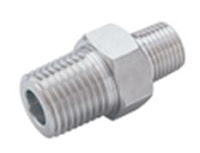The primary purpose of utilizing
pipes is transporting different types of solids, gases and fluids. Hence,
they are constructed using a wide range of raw materials. In order to optimize
its functioning and operation, pipes must be adequately fitted. Pipe fitting
refers to the process of mending or setting up tubes and pipes so that gas,
liquid and solid materials can be transported securely.
When
it comes to determining the types of materials used in the manufacturing of
pipe fittings, the list is unending. From plastic to iron, aluminum, copper and
steel; the type of material used depends on the purpose and extent to which it
will be utilized.
Generally, the pipe fitting is
used for the following reasons:
·
Connecting bores of two or more pipes/tubes,
·
Attaching sections of the pipe,
·
Joining the pipe with some other
equipment/device,
·
Altering the direction of gas or liquid,
·
Managing the flow,
·
Shutting and sealing the pipe/tube.
Since
pipe fittings have a crucial role to play in the transmission of liquids and
gases flowing through it, it’s important to select your pipe fittings wisely by
following the selection criteria stated below:
Kind of Connection
 A pipe fitting generally has two
kinds of connectors. Both ends are threaded from sides; one end slips into
another and adequately fixes into each other to connect the pipes sturdily.
This is often the case with plastic fittings. However, there are other types of
fittings that have identical ends and are capable of f accommodating for any
kind of pipe fitting need.
A pipe fitting generally has two
kinds of connectors. Both ends are threaded from sides; one end slips into
another and adequately fixes into each other to connect the pipes sturdily.
This is often the case with plastic fittings. However, there are other types of
fittings that have identical ends and are capable of f accommodating for any
kind of pipe fitting need. Material Used
As a thumb rule, pipe fittings
must be constructed of the same material as the pipe that is being fitted.
Nonetheless, there are instances where the pipe fitting doesn’t match the pipe
itself; in such cases, pipe fittings that adhere to the predetermined standard
or rules can also be used to fit in pipes.
Flow
To
make sure that the flow of gas, liquid or solid materials remains regulated at
all times, the pipe fitting must be bigger than the pipe itself. This is
important to make sure that the pipe puts up with connections without
compromising with its inner span.
Fitting Type, Size and Thickness
Pipe fittings are identified by
their common types: male threaded, female threaded and slip. When measuring
the
size of these pipe fittings, know that the male threaded fittings are measured
from the outside edge, whereas, the female threaded ones are measured from the
inside. Moreover, pipe fittings come in a wide range of thickness, hence, make
sure you pick the pipe fittings wisely as per your needs.At Seal Excel, find the best angle needle valves, bleed valves and a number of pipe fittings that are manufactured by passing various quality control tests and international benchmarks. To purchase from this instrumentation tube fittings manufacturer, visit their website http://sealexcel.com/ now!







